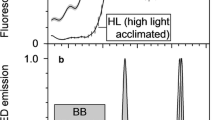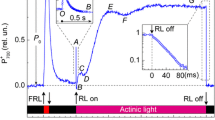Abstract
Light-induced changes in the fluorescence of the pH-indicating dyes pyranine or 5-(and 6-)carboxy-2′, 7′-dichlorofluorescein (CDCF) which had been fed to leaves were examined to monitor cellular pH changes. After short-term feeding of pyranine (pK 7.3) to leaves of Amaranthus caudatus L., a NAD-malic-enzyme-type C4 plant, vascular bundles and surrounding cells became fluorescent. Fluorescence emission from mesophyll cells required longer feeding times. In CO2-free air, pyranine fluorescence increased much more on illumination after mesophyll cells had become fluorescent than when only the vascular bundles and the bundle sheath of Amaranthus leaves had been stained. After short feeding times and in the absence of actinic illumination, CO2 decreased pyranine fluorescence very slowly in Amaranthus and rapidly in C3 leaves. After prolonged feeding times, the extent of the light-dependent increase in pyranine fluorescence was several times greater in different C4 plants than in C3 species. The kinetics of the fluorescence changes were also remarkably different in C3 and C4 plants. Carbon dioxide (500 μl · l−1) suppressed the light-induced increase in pyranine fluorescence more in C4 than in C3 leaves. Light-dependent changes in light scattering, which are indicative of chloroplast energization, and in 410-nm transmission, which indicate chloroplast movement, differed kinetically from those of the changes in pyranine fluorescence. Available evidence indicated that light-dependent changes in pyranine fluorescence did not originate from the apoplast of leaf cells. Microscopic observation led to the conclusion that, after prolonged feeding times or prolonged incubation, changes in pyranine fluorescence emitted from C4 leaves reflect pH changes mainly in the cytosol of mesophyll cells. A transient acidification reaction indicated by quenching of pyranine fluorescence in the dark-light transient and not observed in C3 species is attributed to the carboxylation of phosphoenolpyruvate. After short feeding times and in the absence of actinic illumination, CO2 (250 μl μ l−1) decreased pyranine fluorescence very slowly in Amaranthus and more rapidly in C3 leaves. After prolonged feeding times, both the rate and the extent of CO2-dependent quenching of pyranine fluorescence increased, but the increase was insufficient to indicate the presence of highly active carbonic anhydrase in the compartment from which pyranine fluorescence was emitted. In contrast to pyranine, CDCF (pK 4.8) did not increase but rather decreased its fluorescence on illumination of an Amaranthus leaf, indicating acidification of an acidic compartment, most probably the vacuole of green leaf cells. The pattern of the acidification reaction was similar in C4 and C3 leaves. The remarkably large extent of the light-dependent increase in pyranine fluorescence from leaves of C4 species and its slow kinetics are proposed to be caused by an alkalization of the cytosol which in the absence of CO2 is larger in the mesophyll than in the bundle sheath. It gives rise to deprotonation of dye originally located in the mesophyll and, in addition, of dye which diffuses from the bundle sheath into the mesophyll following a pH gradient. Implications of slow diffusional transport of pyranine and CO2 between mesophyll and bundle-sheath cells and the fast metabolite transport required in C4 photosynthesis are discussed.
Similar content being viewed by others
Abbreviations
- CDCF:
-
5-(and 6-)carboxy-2′,7′-dichlorofluorescein
- DHAP:
-
dihydroxyacetone phosphate
- PGA:
-
3-phosphoglycerate
References
Björkman, O. (1966) The effect of oxygen concentration on photosynthesis in higher plants. Physiol. Plant. 19, 618–633
Burnell, J.N. (1988) An enzymic method for measuring the molecular weight exclusion limit of plasmodesmata of bundle sheath cells of C4 plants. J. Exp. Bot. 39, 1575–1580
Burnell, J.N., Hatch, M.D. (1988) Low bundle sheath carbonic anhydrase is apparently essential for effective C4 pathway operation. Plant Physiol. 86, 1252–1256
Edwards, G.E., Walker, D.A. (1983) C3, C4; Mechanisms, and cellular and environmental regulation of photosynthesis. Blackwell, Oxford
Everson, R.G., Slack, C.R. (1968) Distribution of carbonic anhydrase in relation to the C4 pathway of photosynthesis. Phytochem. 7, 581–584
Felle, H., Bertl, K. (1986) Light-induced cytoplasmic pH changes and their interrelation to the activity of the electrogenic proton pump in Riccia fluitans. Biochim. Biophys. Acta 848, 176–182
Furbank, R.T., Jenkins, C.L.D., Hatch, M.D. (1989) CO2 concentrating mechanism of C4 photosynthesis. Permeability of isolated bundle sheath cells to inorganic carbon. Plant Physiol. 91, 1364–1371
Gutierrez, M., Huber, S.C., Ku, S.B., Kanai, R., Edwards, G.E. (1974) Intracellular location of carbon metabolism in the mesophyll cells of C4 plants. In: Proc. 3rd Internat. Congress on Photosynthesis, pp. 1219–1230, M. Avron, ed. Elsevier, Amsterdam
Hatch, M.D. (1987) C4 photosynthesis: a unique blend of modified biochemistry, anatomy and ultrastructure. Biochim. Biophys. Acta 893, 81–106
Hatch, M.D. (1991) Carbonic anhydrase assay: Strong inhibition of the leaf enzyme by CO2 in certain buffers. Anal. Biochem. 192, 85–89
Hatch, M.D., Burnell, J.N. (1990) Carbonic anhydrase activity in leaves and its role in the first step of C4 photosynthesis. Plant Physiol. 93, 825–828
Hatch, M.D., Osmond, C.B. (1976) Compartmentation and transport in C4 photosynthesis. In: Encyclopedia of plant physiology, N.S., vol. 3: Transport in plants, pp. 144–184, Stocking, C.R., Heber, U., eds. Springer Verlag, Berlin
Heber, U. (1969) Conformational changes of chloroplasts induced by illumination of leaves in vivo. Biochim. Biophys. Acta 180, 302–319
Heber, U., Heldt, H.W. (1981) The chloroplast envelope: structure, function and role in leaf metabolism. Annu. Rev. Plant Physiol. 32, 139–168
Heber, U., Krause, G.H. (1971) Transfer of carbon, phosphate energy and reducing equivalents across the chloroplast envelope. In: Photosynthesis and photorespiration, pp. 218–225, Hatch, M.D., Osmond, C.B., Slatyer, R.O., eds. Wiley, New York
Heldt, H.W., Werdan, K., Milovancev, M., Geller, G. (1973) Alkalisation of the chloroplast stroma caused by light dependent proton flux into the thylakoid space. Biochim. Biophys. Acta 314, 224–241
Jenkins, C.L.D., Furbank, R.T., Hatch, M.D. (1989) Inorganic carbon diffusion between C4 mesophyll and bundle sheath cells. Direct bundle sheath CO2 assimilation in intact leaves in presence of an inhibitor the C4 pathway. Plant Physiol. 91, 1356–1363
Kobayashi, Y., Köster, S., Heber, U. (1982) Light scattering, chlorophyll fluorescence and state of adenylate system in illuminated spinach leaves. Biochim. Biophys. Acta 682, 44–54
Köster, S., Heber, U. (1982) Light scattering and quenching of 9-aminoacridine fluorescence as indicators of the phosphorylation state of the adenylate system in intact spinach chloroplasts. Biochim. Biophys. Acta 680, 88–94
Ku, S.B., Edwards, G.E. (1975) Photosynthesis in mesophyll protoplasts and bundle sheath cells of various types of C4 plants. Z. Pflanzenphysiol. 77, 16–32
Kurkdjian, A., Guern, J. (1989) Intracellular pH: Measurement and importance in cell activity. Annu. Rev. Plant Physiol. Plant Mol. Biol. 40, 271–303
Laisk, A., Oja, V., Kiirats, O., Raschke, K., Heber, U. (1989) The state of the photosynthetic apparatus in leaves as analyzed by rapid gas exchange and optic methods: the pH of the chloroplast stroma, and activation of enzymes in vivo. Planta 177, 350–358
Leegood, R.C. (1985) The intercellular compartmentation of metabolites in leaves of Zea mays. Planta 164, 163–171
Leegood, R.C., Osmond, C.B. (1990) The flux of metabolites in C4 and CAM plants. In: Plant physiology, biochemistry and molecular biology, pp. 274–298, Dennis, D.T., Turpin, D.H., eds. Logman Scientific and Technical, Harlow, UK
Mitchell, P. (1966) Chemiosmotic coupling in oxidative and photosynthetic phosphorylation. Biol. Rev. 41, 445–502
Oja, V., Laisk, A., Heber, U. (1986) Light-induced alkalization of the chloroplast stroma in vivo as estimated from the CO2 capacity of intact sunflower leaves. Biochim. Biophys. Acta 849, 355–365
Pfanz, H., Heber, U. (1986) Buffer capacities of leaves, leaf cells and leaf cell organelles in relation to fluxes of potentially acidic gases. Plant Physiol. 81, 579–602
Rathnam, C.K.M., Das, V.S.R. (1975) Inter- and intracellular distribution of carbonic anhydrase, PEPcarboxylase and RuDP-carboxylase in leaves of Eleusine coracana, a C4 plant. Z. Pflanzenphysiol. 75, 360–364
Raven, J.A. (1986) Biochemical disposal of excess H+ in growing plants? New Phytol. 104, 175–206
Stitt, M., Heldt, H.W. (1985) Generation and maintenance of concentration gradients between mesophyll and bundle sheath in maize leaves. Biochem. Biophys. Acta 808, 400–414
Sze, H. (1985) H-translocating ATPases: Advances using membrane vesicles. Annu. Rev. Plant Physiol. 36, 175–208
Thaler, M., Simonis, W., Schönknecht, G. (1992) Light-dependent changes of the cytoplasmic H+ and Cl− activity in the green alga Eremosphaera viridis. Plant Physiol. 99, 103–110
Wagner, U., Kolbowski, J., Oja, V., Laisk, A., Heber, U. (1990) pH homeostasis of the chloroplast stroma can protect photosynthesis of leaves during influx of potentially acidic gases. Biochim. Biophys. Acta 1016, 115–120
Weiner, H., Burnell, J.N., Woodrow, I.E., Heldt, H.W., Hatch, M.D. (1988) Metabolite diffusion into bundle sheath cells from C4 plants. Relation to C4 photosynthesis and plasmodesmatal function. Plant Physiol. 88, 815–822
Yin, Z.-H., Neimanis, S., Wagner, U., Heber, U. (1990a) Light-dependent pH changes in leaves of C3 plants. I. Recording pH changes in various cellular compartments by fluorescent probes. Planta 182, 244–252
Yin, Z.-H., Neimanis, S., Heber, U. (1990b) Light dependent pH changes in leaves of C3 plants. II. Effect of CO2 and O2 on the cytosolic and vacuolar pH. Planta 812, 253–261
Yin, Z.-H., Dietz, K.-J., Heber, U. (1990c) Light dependent pH changes in leaves of C3 plants. III. Effect of inhibitors of photosynthesis and of developmental state of the photosynthetic apparatus on cytosolic and vacuolar pH changes. Planta 182, 262–269
Yin, Z.-H., Siebke, K., Heber, U. (1991) Light-dependent pH changes in leaves of C3 plants. IV. Action spectra indicate indirect energization of proton transport across the tonoplast by cyclic photophosphorylation. Planta 184, 30–34
Yokota, A., Kitaoka, S. (1985) Correct pK values for dissociation constant of carbonic acid lower the reported K m of ribulose biphosphate carboxylase to half. Presentations of nomograph and an equation for determining the pK values. Biochem. Biophys. Res. Commun. 131, 1075–1079
Author information
Authors and Affiliations
Additional information
This work was supported by the Sonderforschungsbereiche 176 and 251 of the University of Würzburg and by the Gottfried-Wilhelm-Leibniz Program of the Deutsche Forschungsgemeinschaft. A.S.R. was the recipient of a fellowship of the Alexander-von-Humboldt Foundation. We are grateful to Mrs. S. Neimanis for cooperation.
Rights and permissions
About this article
Cite this article
Yin, ZH., Heber, U. & Raghavendra, A.S. Light-induced pH changes in leaves of C4 plants. Planta 189, 267–277 (1993). https://doi.org/10.1007/BF00195086
Accepted:
Issue Date:
DOI: https://doi.org/10.1007/BF00195086




